|
 |
|
 |
|
|
 |
|  |
|
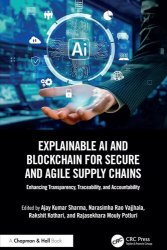 Название: Explainable AI and Blockchain for Secure and Agile Supply Chains: Enhancing Transparency, Traceability, and Accountability Название: Explainable AI and Blockchain for Secure and Agile Supply Chains: Enhancing Transparency, Traceability, and Accountability
Автор: Ajay Kumar Sharma, Narasimha Rao Vajjhala, Rakshit Kothari, Rajasekhara Mouly Potluri
Издательство: CRC Press
Год: 2025
Страниц: 236
Язык: английский
Формат: epub (true)
Размер: 10.1 MB
This book examines the transformative potential of integrating Explainable Artificial Intelligence (XAI) and blockchain technology in modern supply chain management. It explores how these innovative technologies address pressing challenges such as data transparency, traceability, fraud prevention, and operational efficiency in complex global supply chains. With detailed analyses, case studies, and real-world applications, these chapters provide insights into leveraging XAI to demystify AI decision-making and blockchain, ensuring data security and decentralized accountability. Key topics include sustainable practices, smart contract automation, and human-centric approaches to enhancing trust and collaboration among stakeholders. This comprehensive volume serves as a valuable resource for academics, industry leaders, and policymakers seeking to harness cutting-edge technologies for building resilient and transparent supply chains. | |
Разместил: Ingvar16 23-04-2025, 16:24 | Комментарии: 0 | Подробнее
| | | |
 |
|  |
 |
|
 |
|
|
 |
|  |
|
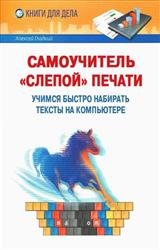
Название: Самоучитель "слепой" печати. Учимся быстро набирать тексты на компьютере
Автор: Гладкий Алексей
Издательство: Litres
Год: 2013
Формат: rtf, fb2
Размер: 10,7 мб
Качество: хорошее
Язык: русский
Данная книга адресована пользователям, желающим в короткие сроки освоить методику быстрого набора текста на персональном компьютере. Помимо теоретического материала, в книге приводится большое количество практических упражнений. | |
Разместил: gol8425 23-04-2025, 11:39 | Комментарии: 0 | Подробнее
| | | |
 |
|  |
 |
|
 |
|
|
 |
|  |
|
 Название: Python Uncoiled: From Print Statements to Power Scripts Название: Python Uncoiled: From Print Statements to Power Scripts
Автор: Scott Markham
Издательство: Independently published
Год: 2025
Страниц: 224
Язык: английский
Формат: pdf, epub, mobi
Размер: 10.1 MB
Tired of staring at blinking cursors and wondering what sorcery lies behind all those lines of code? Wish you could make your computer do literally anything besides throw errors and play Minesweeper? Welcome to Python Uncoiled: From Print Statements to Power Scripts—your all-access pass to turning Python from a mystery into your personal code-powered sidekick. This isn't your average dry-as-dust programming book. Nope—we're slinging jokes, wrangling data, scraping websites, writing scripts that do your chores (well, digital ones), and having a blast along the way. Whether you're a total newbie or a techie looking to finally "get" Python, this book walks you through loops, functions, APIs, automation, debugging, and even building real-world power scripts that save time, impress coworkers, and make you feel a little bit like a wizard. | |
Разместил: Ingvar16 23-04-2025, 08:08 | Комментарии: 0 | Подробнее
| | | |
 |
|  |
 |
|
 |
|
|
 |
|  |
|
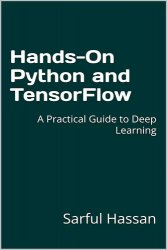 Название: Hands-On Python and TensorFlow: A Practical Guide to Deep Learning Название: Hands-On Python and TensorFlow: A Practical Guide to Deep Learning
Автор: Sarful Hassan
Издательство: MechatronicsLAB
Год: 2025
Страниц: 362
Язык: английский
Формат: pdf, epub, mobi
Размер: 10.1 MB
"Hands-On Python and TensorFlow: A Practical Guide to Deep Learning" is the ultimate resource for learning deep learning with Python and TensorFlow. This book is perfect for beginners and experienced developers alike who want to master Machine Learning and AI. Learn to build real-world Deep Learning models, including image classification, object detection, time series forecasting, and more, using TensorFlow and Python. Inside, you’ll find clear, easy-to-follow explanations of core Deep Learning concepts like neural networks, tensors, model training, and optimization techniques. With practical, hands-on examples and exercises, you’ll gain the skills to develop, train, and deploy Deep Learning models for various applications. Whether you're interested in AI, Machine Learning, or neural network development, this book will equip you with the knowledge and experience to build advanced Machine Learning models using TensorFlow. By the end of the book, you’ll be able to apply these techniques to solve complex problems and create AI-powered applications. | |
Разместил: Ingvar16 23-04-2025, 07:20 | Комментарии: 0 | Подробнее
| | | |
 |
|  |
 |
|
 |
|
|
 |
|  |
|
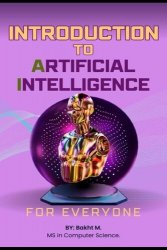 Название: Introduction to Artificial Intelligence Название: Introduction to Artificial Intelligence
Автор: Bakht Muhammad
Издательство: Independently published
Год: October 14, 2024
Страниц: 237
Язык: английский
Формат: epub
Размер: 39.0 MB
"Introduction to Artificial Intelligence" by Bakht Muhammad is more than just a book—it’s your passport to the future! Dive into 237 pages of thrilling exploration into the world of AI, where technology meets imagination. Bursting with vivid pictures, detailed diagrams, and crystal-clear explanations, this guide transforms complex ideas into something you’ll not only understand but enjoy. Whether you’re starting from scratch or leveling up your knowledge, this book makes AI accessible and exciting. This book provides a comprehensive guide to understanding the fundamentals of Artificial Intelligence (AI). From Machine Learning to natural language processing (NLP), it introduces core concepts in an easy-to-understand way, making it perfect for beginners. Whether you're a student, tech enthusiast, or a professional looking to explore AI, Introduction to Artificial Intelligence offers practical insights into how AI is shaping the future of technology. | |
Разместил: Ingvar16 23-04-2025, 06:38 | Комментарии: 0 | Подробнее
| | | |
 |
|  |
 |
|
 |
|
|
 |
|  |
|
 Название: Элегантный SciPy Название: Элегантный SciPy
Автор: Нуньес-Иглесиас Х., Уолт ван дер Ш., Дэшноу Х.
Издательство: ДМК Пресс
Год: 2018
Cтраниц: 266
Формат: pdf (ocr)
Размер: 25 мб
Язык: русский
Книга познакомит вас с основополагающими компонентами библиотеки SciPy языка Python. Вы научитесь писать элегантный, ясный, краткий и эффективный программный код благодаря примерам из обширной научной экосистемы Python. Кроме SciPy, вы узнаете много нового про сопутствующие библиотеки, такие как NumPy, Pandas, scikit-image. Издание будет полезно всем программистам на Python, желающим использовать научные библиотеки в своей работе. | |
Разместил: rivasss 23-04-2025, 06:29 | Комментарии: 0 | Подробнее
| | | |
 |
|  |
 |
|
 |
|
|
 |
|  |
|
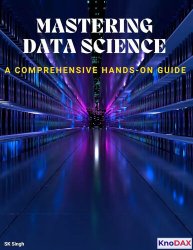 Название: Mastering Data Science: A Comprehensive Hands-on Guide Название: Mastering Data Science: A Comprehensive Hands-on Guide
Автор: SK Singh
Издательство: KnoDAX
Год: 2025
Страниц: 781
Язык: английский
Формат: epub
Размер: 10.1 MB
Unlock the Full Potential of Data Science with Python. In the era of data-driven decision-making, Mastering Data Science: A Comprehensive Hands-On Guide serves as an essential resource for aspiring and experienced data scientists alike. Whether you're just getting started or looking to sharpen your skills, this book provides a structured, practical, and hands-on approach to mastering Data Science. Data Science is a rapidly growing field that combines programming, statistics, and domain expertise to extract insights from data. The Chapter 1 introduces the fundamentals of Data Science, exploring its definition, key components, and real-world applications. It covers the role of a data scientist, the Data Science workflow, and essential tools and technologies used in the field. Additionally, it highlights why Python is the preferred language for Data Science, emphasizing its simplicity, versatility, and rich ecosystem of libraries. | |
Разместил: Ingvar16 23-04-2025, 05:49 | Комментарии: 0 | Подробнее
| | | |
 |
|  |
 |
|
 |
|
|
 |
|  |
|
 Название: Introduction to Operations Research: 2024 Release Название: Introduction to Operations Research: 2024 Release
Автор: Frederick Hillier, Gerald Lieberman
Издательство: McGraw Hill LLC
Год выхода: 2024
Страниц: 1332
Формат: True PDF
Размер: 28,3 MB
Язык: английский
Introduction to Operations Research is the classic text on operations research. While building on the classic strengths of the text, the author continues to find new ways to make the text current and relevant to students. One way is by incorporating a wealth of state-of-the art, user-friendly software and more coverage of business applications than ever before. When the first co-author received the prestigious Expository Writing Award from INFORMS for a recent edition, the award citation described the reasons for the book’s great success as follows:
“Two features account for this success. First, the editions have been outstanding from students’ points of view due to excellent motivation, clear and intuitive explanations, good examples of professional practice, excellent organization of material, very useful supporting software, and appropriate but not excessive mathematics. Second, the editions have been attractive from instructors’ points of view because they repeatedly infuse state-of-the-art material with remarkable lucidity and plain language.” | |
Разместил: Dovegone 22-04-2025, 23:31 | Комментарии: 0 | Подробнее
| | | |
 |
|  |
 |
|
 |
|
|
 |
|  |
|
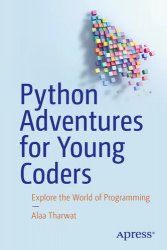 Название: Python Adventures for Young Coders: Explore the World of Programming Название: Python Adventures for Young Coders: Explore the World of Programming
Автор: Alaa Tharwat
Издательство: Apress
Год: 2025
Страниц: 352
Язык: английский
Формат: pdf (true), epub (true)
Размер: 56.6 MB
This book takes young readers on an exciting adventure with a child named Kai. One day, Kai wakes up trapped inside a giant robot. He can't talk to anyone outside, and the only way to communicate is through the robot. Inside the robot, Kai finds many books and documents written in a strange language—it's the robot's language, which is Python. Kai realizes he needs to learn this language to control the robot and talk to the outside world. In each chapter in this book, we will join Kai on a new adventure to learn something that helps us control the robot better and communicate with the real world. This fun and interactive book is designed to introduce young minds to the basics of programming while encouraging creativity and problem-solving skills. This book caters primarily for high school students and individuals keen on delving into programming with minimal or zero coding background. | |
Разместил: Ingvar16 22-04-2025, 21:43 | Комментарии: 0 | Подробнее
| | | |
 |
|  |
 |
|
 |
|
|
 |
|  |
|
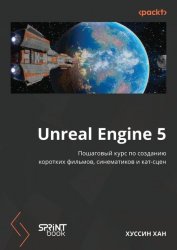 Название: Unreal Engine 5. Пошаговый курс по созданию коротких фильмов и синематиков Название: Unreal Engine 5. Пошаговый курс по созданию коротких фильмов и синематиков
Автор: Хуссин Хан
Издательство: Спринт Бук
Год: 2025
Страниц: 448
Язык: русский
Формат: pdf
Размер: 44.7 MB
Unreal Engine 5 — не просто инструмент для разработки игр. Это революционная платформа для кинопроизводства, анимации и виртуального продакшена, которую используют Disney, Industrial Light & Magic и другие студии такого уровня. Технологии, на которых сделан сериал «Мандалорец», теперь доступны и вам! Эта книга — проводник в мир создания короткометражных фильмов, синематиков и гибридных проектов, где живые съемки сливаются с цифровыми мирами. Хуссин Хан, опираясь на многолетний опыт создания визуальных эффектов, анимации и виртуальной реальности, предлагает полноценный курс — от основ UE5 до продвинутых техник. | |
Разместил: Ingvar16 22-04-2025, 21:02 | Комментарии: 0 | Подробнее
| | | |
 |
|  |
|